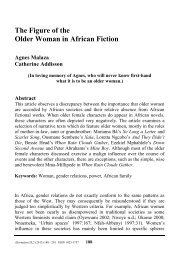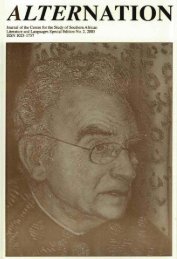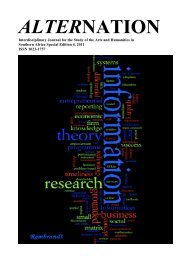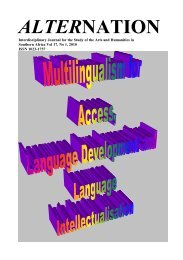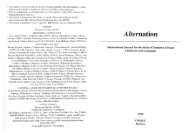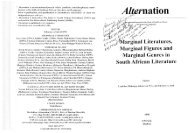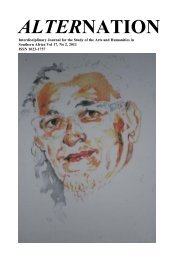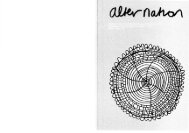Shane Moran - Alternation Journal
Shane Moran - Alternation Journal
Shane Moran - Alternation Journal
You also want an ePaper? Increase the reach of your titles
YUMPU automatically turns print PDFs into web optimized ePapers that Google loves.
Alex lil Gzlnla .? Politics and Aestliet<br />
z~lani Mkhize<br />
is signit'icant when one considers that 'Soviet Marxism 011 its philosophical side, w<br />
can be inferred from these statements, the validity of Plekhanov's thesis lies in its<br />
rooted in Plekhanov and Lenin' (Lichtheim 1970:57). There is ample evidence that<br />
mpt to demystify the terms of these opposing perspectives on art by locating thein in<br />
Guma read Plekhanov's Unaddressed Letters. Avt and Social Life ([I 899- 19001 1 orical contexts or social conditions within which they thrive'! It could be argued<br />
and appropriated some of' Plekhanov's ideas by incorporating them into his<br />
at it is because of Plekhanov's rejection of 'prescription in art' that La Guma appeals<br />
discourse.<br />
Lenin's principle of partisanship, thereby finding a resolution to the impasse that<br />
In his essay, 'Has Art Failed South Africa?', which appeared in The Afric<br />
ekhanov's aesthetic theory seems to create for him in this regard27.<br />
Conznzzlnist in 1977, La Gurna employs Plekhanov in his endorsement of ideologica<br />
In all his extra-fictional statements La Gumapersistently denounces the art for<br />
oriented artistic production. He points out in his critique of the art for art's sake schoo 's sake argument and espouses autilitarian view of art. This is best exemplified in the<br />
ofthought in South Africa:<br />
lowing statement made by La Guma (1 97 1 : 1 13):<br />
The black artist in Soutli Africa is not averse to mixing his work with It is perhaps possible. within the environment of developed societies, to<br />
'politics': Ire cannot but accept that as one of the victims of the oppressive create with a certain amount of confidence the inipression that the art,<br />
society, his work almost automatically becomes involved ... for us or the culture, the level of civilisation of a people have nothing. or little to do with<br />
conscious artist. man is not made for the Sabbath, but the Sabbath for socio-economic and political forces within these societies; that culture has<br />
man-society is not made for the artist. but the artist for society. The<br />
function of art is to assist the development of man's consciousness, to help<br />
improve society (La Guma 1977:82).<br />
nothing to do with politics. In South Africa this is not possible. The<br />
proposition of art for the sake of art finds no footliold in the atmosphere of<br />
racism. violence and crude exploitation whiclr is the day-to-day experience<br />
of the South Afiican people.<br />
He then goes on to attack those artists who reject a utilitarian view of art citi<br />
Plekhanov's argument '[alrt for art's sake arises essentially where the artist is out<br />
is particularly striking here is not so much La Guma's rejection of art for art's sake<br />
harmony with his social environment' (La Guma 1977:83). He accuses these artists sition and the way in which he embraces a utilitarian view of art by underscoring<br />
being in 'ivory towers' taking 'refuge from the slings and arrows of an outrage0 inseparability of culture and politics, but it is the fact that there is an element of<br />
society' (La Guma 1977:82). La Guma's essay was written as a rejoinder to Ce tativeness with regard to his use of these two positions in this statement. In short,<br />
Skotnes (1976), a South African artist, who had expressed his concert1 about what h is an unarticulated assumption that in a post-apartheid society, under a different<br />
saw as 'a singular lack of guts' in South African art despite the existence of what<br />
described as 'a classic revolutionary situation' that could stimulate a proliferation<br />
artistic production. In his, argument Skotnes had particularly sit~gled out what<br />
ical or social setting, there will be a shift from the contemporary discursive<br />
on. Indeed, this seems to be confirmed towards the end of the essay:<br />
perceived as a 'lack of a strong artistic tradition' on 'the Black Front' and expressed<br />
reservations about the merit of art that is 'bound to ... political institutions in general<br />
As can be inferred it is precisely with these particular aspects of Skotnes's argumen<br />
that La Guma takes issue and recruits Plekhanov to make a case for black artists.<br />
Plekhanov distinguishes between those artists who perceive art in terins o<br />
As long as racism and oppression last in Southern Africa. culture will take<br />
this form. When tlie oppressed have freed themselves from the shackles of<br />
their responsibility to soc6ty, those who argue that the function of art is to assist t<br />
development of man's consciousness, to improve the social system, on the one han<br />
and those who see art as an end in itself on the other (Plekhanov 1957: 149). He then u<br />
various examples from different historical contexts to test the viability of these t<br />
opposing views. Plekhanov's investigation leads him to the following conclusion<br />
the art for art's sake school ofthought: 'The belief in art for art's sake arises when artis<br />
and people keenly interested ,in art are hopelessly out of harmony with their soci<br />
environment' (Plekhanov 1957: 163). On the contrary, theutilitarian view of art<br />
'Regine Robin (1992:150), who traces the origins of socialist realism and underscores its<br />
contradictions, argues that 'for Plekhanov, art is a socio-historical pllenonienon, a thought. an<br />
idea, a content, sonrething to express, something that is expressed tl~rough images. It is a<br />
reflection of reality. anchored in its time, which attains perfection when the relation between form<br />
aud content is ~naxirnally adequate'.<br />
"<br />
Demetz (1967:197) sees this rejection of prescription in art as Plekhanov's 'llalf-hearted<br />
defence of the principle of l'nrtpozlr l'arl'. Robin (1992: 150) comments: 'AI-t for art's sakc is<br />
always the sign of retreat fro111 the social: one needs to analysc wliy this retreat from the social.<br />
that is. the tendency to impart to its production the signiticance ol'<br />
judgenients 011 the phenomenon of life, and the joyf~~l eagel-ncss, which<br />
always accompanies it. to take part in social strife. arises and spreads<br />
~vhcnever there is mutual sy~npatiry bct~;een a considerable section of<br />
society and people who have more or less active intercst in creative art<br />
(Plekhanov 1957: 163).<br />
liistorically speaking, imposes itself on certain artists. That is wily Plekhanov abandons the<br />
"social utility" of art as an immanent principle. In so doing he creates a considerable shift in what<br />
we have called the disc~~rsive base of realist aesthetics: Ire opens lip an ambiguity. a shadowy zone<br />
that, in conjunction with Iris reiection of pl.escriptio11 in art. would suffice to explain wliy lie was<br />
blacklistcd as a Menshevik and as the creator of a passive aesthetic in tlie Soviet socicty of tlie<br />
158<br />
159



